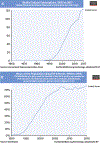Gerotechnology for Older Adults With Cardiovascular Diseases: JACC State-of-the-Art Review
- PMID: 33243384
- PMCID: PMC10436190
- DOI: 10.1016/j.jacc.2020.09.606
Gerotechnology for Older Adults With Cardiovascular Diseases: JACC State-of-the-Art Review
Abstract
The growing population of older adults (age ≥65 years) is expected to lead to higher rates of cardiovascular disease. The expansion of digital health (encompassing telehealth, telemedicine, mobile health, and remote patient monitoring), Internet access, and cellular technologies provides an opportunity to enhance patient care and improve health outcomes-opportunities that are particularly relevant during the current coronavirus disease-2019 pandemic. Insufficient dexterity, visual impairment, and cognitive dysfunction, found commonly in older adults should be taken into consideration in the development and utilization of existing technologies. If not implemented strategically and appropriately, these can lead to inequities propagating digital divides among older adults, across disease severities and socioeconomic distributions. A systematic approach, therefore, is needed to study and implement digital health strategies in older adults. This review will focus on current knowledge of the benefits, barriers, and use of digital health in older adults for cardiovascular disease management.
Keywords: arrhythmia; barriers; cardiac rehabilitation; clinical trials; diabetes mellitus; digital health; dyslipidemia; gerotechnology; heart failure; hypertension; obesity; older adults; palliative care; telehealth.
Copyright © 2020 American College of Cardiology Foundation. Published by Elsevier Inc. All rights reserved.
Conflict of interest statement
Author Disclosures Dr. Dorsch is supported by R18 HS026874 and R21 HS026322 from the Agency for Health Research and Quality, R01 AG062582 from the National Institutes of Health (NIH)/National Institute of Aging, and the American Health Association Health IT Research Network; has received honoraria from Janssen; and has received research funding from Bristol Myers Squibb/Pfizer and Amgen in the past 2 years. Dr. Dodson is supported by K23 AG052463 from the NIH/National Institute of Aging, and R01 AG062520 from the NIH/National Institute of Aging. Dr. Masterson Creber is supported by NIH/National Institute of Nursing Research R00NR016275, and NIH/National Heart, Lung, and Blood Institute R01HL152021. Dr. Kitsiou is supported by the NIH/National Institute of Nursing Research R01NR017635 and R21NR018281, NIH/National Heart, Lung, and Blood Institute R61HL139454, and NIH/National Institute on Aging P30AG022849. Dr. Goyal is supported by the National Institute on Aging (NIA) grant R03AG056446 and American Heart Association grant 18IPA34170185. Dr. Maurer has received grant support from National Institutes of Health R01HL139671-01, R21AG058348, and K24AG036778; has received consulting income from Pfizer, GlaxoSmithKline, EIdos, Prothena, Akcea, and Alnylam; and his institution has received clinical trial funding from Pfizer, Prothena, Eidos, and Alnylam. Dr. Batsis is supported in part by the National Institute on Aging of the National Institutes of Health under Award Number K23AG051681 and R01-AG067416; and has part ownership in a patent developed for the Instrumented Resistance Exercise Device (Dartmouth Patent application # 62/672,827). Dr. Turakhia has received grants unrelated to this work from Apple, Janssen, Bayer, AstraZeneca, Boehringer Ingelheim, the American Heart Association, and Bristol Myers Squibb; has been a consultant to Medtronic, Biotronik, Pfizer, Bayer, Novartis, Sanofi, Johnson & Johnson, Myokardia, and Milestone Pharmaceuticals unrelated to this work; and is an editor for JAMA Cardiology. Dr. Forman is supported by the NIH National Institute on Aging R01AG060499-01, R01AG058883, and P30AG024827, and the NIH Common Fund U01AR071130. Dr. Bernacki is supported by T32HL125195-04 from the NIH/National Heart, Lung, and Blood Institute. Dr. Peterson has received research funding from AstraZeneca, Janssen, Amgen, and Sanofi unrelated to this work. Dr. Freeman does nonpromotional speaking for Boehringer Ingelheim; has served on Advisory Boards for The Medicines Company and Regeneron; and has served as a consultant for Actelion, none of which are related to the work submitted. Dr. Bhavnani has served as a scientific advisor to Analytics 4 Life and Blumio; has served as a consultant to Bristol Myers Squibb and Pfizer; and has received research support from Scripps Clinic, Alliance Healthcare Foundation, and the Qualcomm Foundation outside of the present work. All other authors have reported that they have no relationships relevant to the contents of this paper to disclose. The views expressed in this paper are by members of the American College of Cardiology’s Innovation Council, Cardiovascular Team Council and the Geriatric Cardiology Section Leadership Council and do not necessarily reflect the views of the Journal of the American College of Cardiology or the American College of Cardiology.
Figures



References
-
- World Health Organization. mHealth - New horizons for health through mobile technologies Available at: https://www.who.int/goe/publications/goe_mhealth_web.pdf. Accessed February 4, 2020.
-
- Powell AC, Landman AB, Bates DW. In search of a few good apps. JAMA 2014;311:1851–2. - PubMed
-
- Pagoto S, Schneider K, Jojic M, DeBiasse M, Mann D. Evidence-based strategies in weight-loss mobile apps. Am J Prev Med 2013;45:576–82. - PubMed
Publication types
MeSH terms
Grants and funding
- R18 HS026874/HS/AHRQ HHS/United States
- P30 AG024827/AG/NIA NIH HHS/United States
- R01 AG058883/AG/NIA NIH HHS/United States
- R00 NR016275/NR/NINR NIH HHS/United States
- R03 AG056446/AG/NIA NIH HHS/United States
- P30 AG022849/AG/NIA NIH HHS/United States
- R01 AG060499/AG/NIA NIH HHS/United States
- R01 AG062582/AG/NIA NIH HHS/United States
- K24 AG036778/AG/NIA NIH HHS/United States
- R03 AG056444/AG/NIA NIH HHS/United States
- R01 HL152021/HL/NHLBI NIH HHS/United States
- K23 AG052463/AG/NIA NIH HHS/United States
- R01 AG067416/AG/NIA NIH HHS/United States
- K23 AG051681/AG/NIA NIH HHS/United States
- R61 HL139454/HL/NHLBI NIH HHS/United States
- R21 NR018281/NR/NINR NIH HHS/United States
- R01 NR017635/NR/NINR NIH HHS/United States
- R01 AG062520/AG/NIA NIH HHS/United States
- U01 AR071130/AR/NIAMS NIH HHS/United States
- R21 HS026322/HS/AHRQ HHS/United States
- R01 HL139671/HL/NHLBI NIH HHS/United States
- T32 HL125195/HL/NHLBI NIH HHS/United States
- R21 AG058348/AG/NIA NIH HHS/United States
LinkOut - more resources
Full Text Sources
Medical

